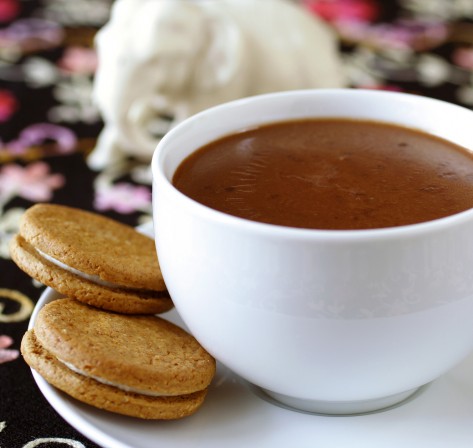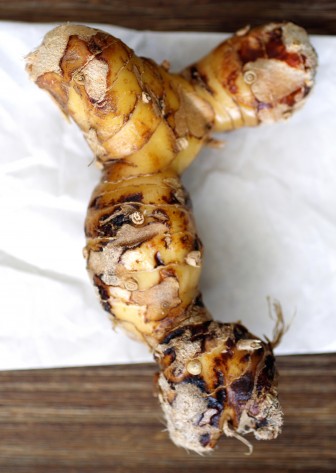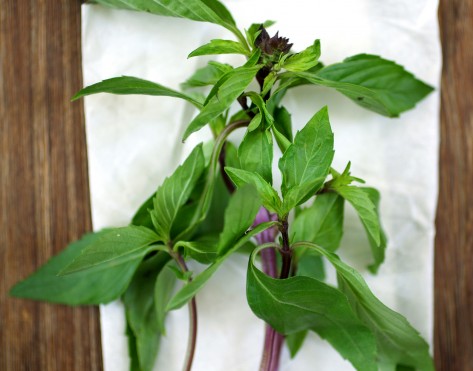Drinking Chocolate, Southeast Asian Style

This is galangal.

It is not the same as mandrake, the root that Ofelia, the protagonist in Pan’s Labyrinth, placed under her sick mother’s bed.
But it’s nearly as odd looking. Instead of being used in magic rituals, as the mandrake has long been, galangal is used to make food taste good in Southeast Asia, and in Thailand in particular, where it is used to flavor soups and curry pastes.
I used it along with a single-origin Vietnamese chocolate from Grand-Place, shown below,

to design a drinking chocolate recipe with the current DCCC pick, Thai Food by David Thompson, in mind.
Only after, however, trying an alternative version with leafy green Thai basil.

A few years ago I successfully joined Thai basil and chocolate in a recipe for chilled drinking chocolate, shaken and served up in a martini glass for a non-alcoholic quaff (Asian Cocktails, Tuttle Publishing).
Here, though, assertive Thai basil distracts from the unique spicy and fruity flavors of the Vietnamese chocolate.
The flavor of galangal, a relative of ginger, can be peppery, like its cousin rhizome, but is subtler and more low-key. It amplifies rather than competes with the flavor the Grand-Place chocolate. A touch of palm sugar (substitute light brown sugar), also used in Thai cooking, rounds out the tangy flavor of the chocolate, and smooths its naturally astringent tannins (the darker the chocolate, the higher the amount of tannins); and its sufficient personalty (compared with plain old white sugar) is a good match for the slightly medicinal (but pleasantly so) taste of the galangal. Before adding the sugar, however, try the drinking chocolate; you may decide you like the sweetness level as is.
It would have made more sense to make a Thai-themed drinking chocolate with Thai chocolate. Since the latter doesn’t exist, the versatile yet individual single-origin chocolate of nearby Vietnam—geographically, only Laos to the north and Cambodia to the south come between Thailand and Vietnam—is a natural alternative.
Single-Origin Vietnamese Drinking Chocolate
Makes three 6-ounce servings
1½ ounces galangal, sliced (see Notes)
2¾ cups whole milk
3 ounces Vietnamese chocolate (72% cacao), chopped (see Notes)
Small pinch of sea salt
⅛ teaspoon vanilla extract
1 tablespoon palm sugar or light brown sugar (optional)
Combine the galangal and milk in a small, heavy saucepan. Bring to a gentle boil over medium heat, stirring frequently. (If your saucepan has a thin bottom, heat the milk over medium-low heat.) Reduce the heat to low and cook at a slow simmer for 15 minutes, stirring occasionally. (If you think you may have scorched the milk, do not scrape the bottom of the pan when stirring.) Strain the milk, pressing against the sieve to extract any remaining liquid; discard the galangal. The milk will have reduced by about ⅓ cup.
Place the chocolate and about ¼ cup of the stained milk in the saucepan. Melt the chocolate over medium-low heat, stirring continuously until the chocolate is completely melted. Add the remaining of milk in a steady stream, while stirring. Bring to a gentle simmer, stir in the salt, vanilla, and sugar if using and serve.
Notes:
If you cannot find fresh galangal, use 1 ounce ginger, peeled and sliced.
Grand-Place is an independent Belgian chocolate manufacturer that caters to the needs of professionals. Last year they launched the world’s first ever 100-percent single-origin chocolate from Vietnam. Grand-Place works closely with Vietnamese cacao farmers, and considers their single-origin chocolate a very environmentally friendly product as everything is done in Vietnam—from the growing of the beans to the manufacture of the chocolate.
Grand-Place chocolate can be purchased from their US office. The smallest amount available of the single-origin Vietnamese chocolate is a 1-kg block. The introductory price is $9.45. Shipping is not included. Though their primary market is professionals, they will sell a block to chocolate lovers like you and me.
Grand-Place® US Inc.
18 River Street, Upton,
Massachussets 01568, USA
Roberta White, sales manager
Tel: +508-529-6044
Cell: +508-243-8674
Fax: +508-529-6038
roberta@grandplacechocolate.com
Version 2: Drinking Chocolate with a Blended Base
Makes four 6-ounce servings
1½ ounces galangal, sliced (see Notes, above)
3½ cups whole milk
4 tablespoons Dutch-processed (alkalinized) cocoa powder
2 ounces bittersweet chocolate (52 to 55% cacao), chopped
1½ tablespoons sugar
Pinch of sea salt
Scant ¼ teaspoon vanilla extract
Combine the galangal and milk in a small, heavy saucepan. Bring to a gentle boil over medium heat, stirring frequently. (If your saucepan has a thin bottom, heat the milk over medium-low heat.) Reduce the heat to low and cook at a slow simmer for 15 minutes, stirring occasionally. (If you think you may have scorched the milk, do not scrape the bottom of the pan when stirring.) Strain the milk, pressing against the sieve to extract any remaining liquid; discard the galangal. The milk will have reduced by about ⅓ cup.
Place the cocoa powder in the saucepan. While stirring continuously, over medium-low heat, gradually add ¼ cup of the strained milk, a tablespoon at a time. Continue stirring until all lumps of cocoa are incorporated and the mixture is smooth.
Add the chocolate and reduce the heat to low. Gradually add another ¼ cup of the milk, while stirring. Heat until the chocolate is melted, stirring often. Add the remaining milk in a steady stream, while stirring. Bring to a gentle simmer. Stir in the sugar, salt, and vanilla and serve.

Holly Jennings, you are the queen of drinking chocolate. And thank you for the photo of galangal, because I’ve never actually seen it before!
1You’re too kind. Well, every queen needs cherished advisors, and you’re one of them. I hadn’t seen galangal before either. Apparently, from a description in David Thompson’s book, the galangal in my photo is older. When young, the skin is thin and white and as it ages it becomes yellow and even red, and the taste become stronger. When it’s young it’s best in soups; when old, in curry pastes, he says. Naturally, he doesn’t say what age is best for drinking chocolate.
2